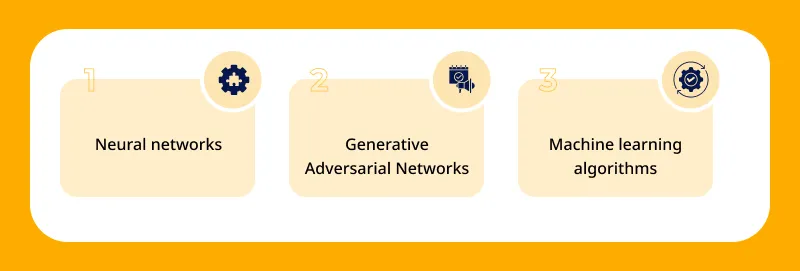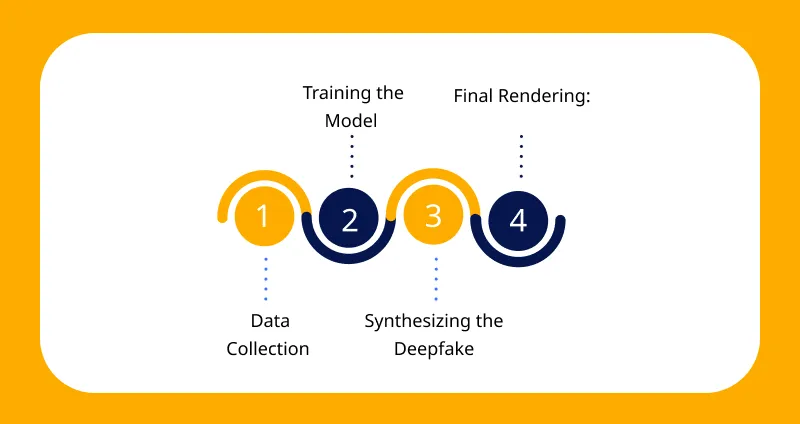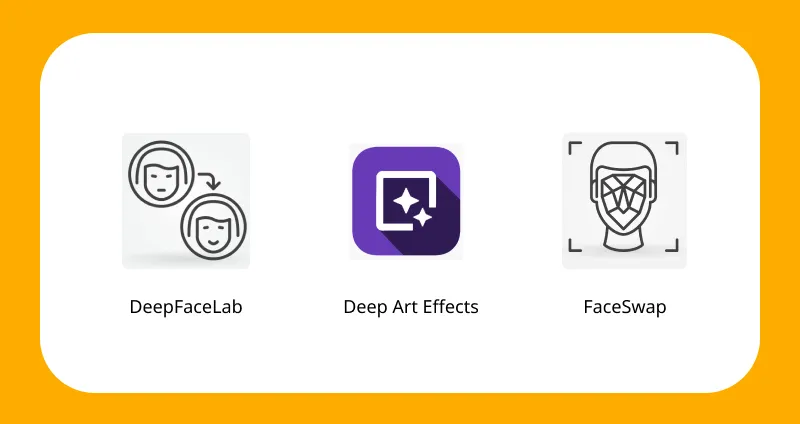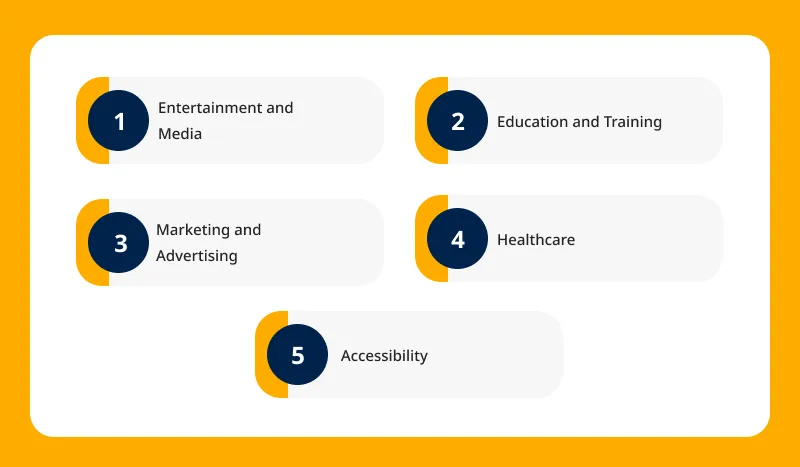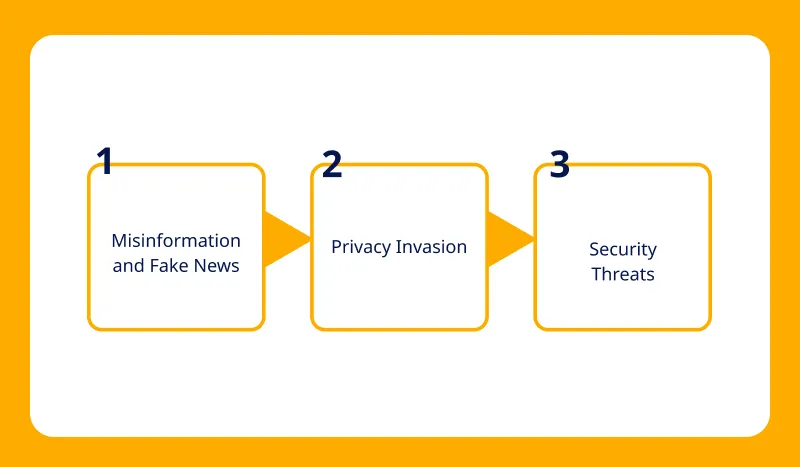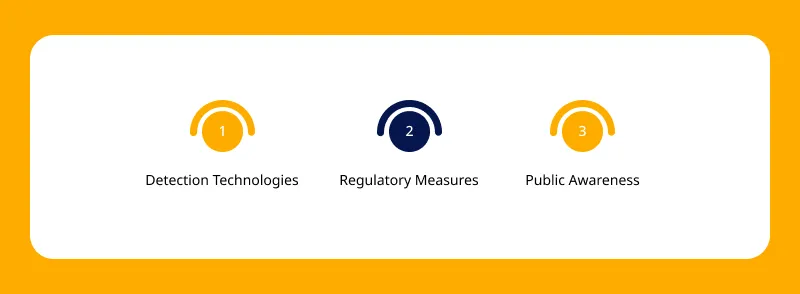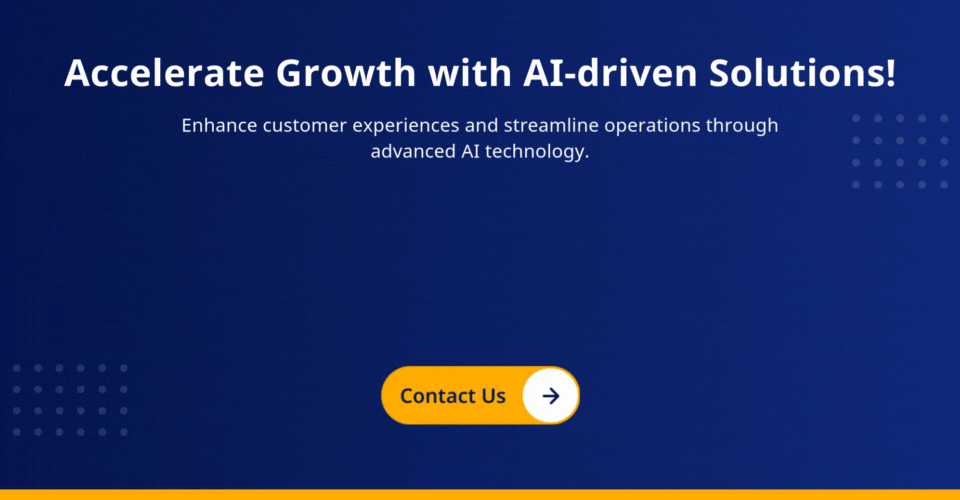Have you ever imagined a scenario in which you could make anyone say or do anything on video, regardless of whether it happened?
Yes, this is possible now because of deep fake AI technology. It uses advanced machine learning algorithms to create hyperrealistic, manipulated videos that can be fascinating and frightening.
According to DeepMedia, the total number of online deep fake videos doubled in 2023, reaching an unexpected 500,000 video and voice deep fakes. Moreover, we can expect around 8 million deepfakes on social media in 2025.
The potential applications of Deepfake AI technology range from revolutionizing entertainment and marketing to posing significant security challenges. So, check out this blog post to learn what Deepfake AI technology is, how it works, and what its vast implications are for our future.
Craft immersive, memorable brand stories that resonate deeply with your audience, setting you apart from competitors.
Deepfake Technology Explained Here
Deepfake AI technology refers to synthetic media where a person’s likeness, including appearance and voice, is artificially replicated using advanced AI algorithms.
The term “deepfake” refers to the combination of deep learning, which is a subset of artificial intelligence, focused on neural networks with many layers. And, the term “fake” indicates the creation of realistic, yet fabricated content.
The core technologies powering deepfake AI technology include:
- Neural networks
- Generative Adversarial Networks
- Machine learning algorithms
How Deepfake Technology Works?
Creating deepfake AI-generated content involves a sophisticated process that starts with data collection and ends with the final rendering process, as discussed below.
Steps Involved In Creating Deepfake Images & Videos
Understanding the intricate process behind deepfake AI technology reveals its impressive capabilities and the complexities involved in creating such realistic synthetic media. It involves several steps using Generative AI development, as discussed below:
1. Data Collection: The data collection process starts with gathering the target individual’s extensive visual and audio data. This includes video clips, images, and voice recordings, which are used to train the AI model.
2. Training the Model: The model is trained on the collected data using neural networks and GANs. The generator learns to create synthetic content that mimics the target, while the discriminator learns to identify any inconsistencies, pushing the generator to improve.
3. Synthesizing the Deepfake: Once the model is sufficiently trained, it generates new content featuring the target individual. This involves aligning the synthetic visuals and audio with the desired actions and expressions.
4. Final Rendering: The generated content is then fine-tuned and rendered into a polished video or audio clip. This step may involve additional post-processing techniques to enhance realism and address any remaining artifacts.
Moreover, central to creating the impact of Deepfakes is a type of artificial intelligence known as Generative Adversarial Networks (GANs). It consists of two neural networks:
- The generator creates fake images or videos.
- The discriminator evaluates their authenticity.
These networks are pitted against each other in a continuous loop, with the generator striving to produce increasingly realistic content and the discriminator becoming more adept at identifying fakes. This results in highly convincing deepfake images and videos.
Create dynamic, tailored ads that resonate with your audience, boosting engagement and conversions.
Tools & Technologies Used
Top AI development firms have developed Several tools and software to facilitate the creation of Deepfakes, making Deepfake AI technology accessible to a broader audience. Among the most popular are:
- DeepFaceLab: This open-source software is widely used to create Deepfakes. It gives a wide range of features such as face swapping and facial reenactment, and supports multiple neural network architectures to produce high-quality Deepfake videos.
- FaceSwap: Another open-source tool, FaceSwap, allows users to swap faces in images and videos. It employs machine learning techniques to align and blend facial features, creating realistic outputs seamlessly.
- Deep Art Effects: Although not specifically a deepfake tool, this software uses neural networks to transform images and videos into artistic styles, showcasing the versatility of AI-generated content.
Applications of Deepfake AI
In our last blog post, “Building an AI Chatbot,” we saw several applications of AI for dynamic pricing and catering to different consumer needs. Similarly, you can find various applications of Deepfake AI technology here:
1. Entertainment and Media
Deepfake AI technology has found significant applications in the entertainment and media industries, revolutionizing the production of special effects and computer-generated imagery in movies and TV shows.
By seamlessly integrating synthetic faces and voices, filmmakers can generate lifelike characters and scenes with remarkable accuracy. This technology allows for hyper-realistic and de-aging effects in media and entertainment software development.
Here are some notable examples of Deepfakes using AI consulting services:
- Advanced deepfake techniques were used to recreate the likeness of the late Carrie Fisher in the “Star Wars” franchise, providing a seamless continuation of her character.
- Historical figures like Albert Einstein and Salvador Dali have been brought back to life through AI deepfake technology for educational purposes, museum exhibits, and promotional content.
2. Education and Training
Deepfake AI technology is making notable strides in education and training. It offers innovative solutions to enhance learning experiences and training simulations. Here’s how deepfake AI technology is being utilized:
Deepfake AI technology creates highly realistic training simulations, providing immersive experiences for learners.
- The impact of Deepfakes simulates complex scenarios and interactions in fields like emergency response, allowing trainees to practice and refine their skills in a controlled, virtual environment.
- These simulations can replicate real-world situations with remarkable accuracy, providing valuable hands-on experience without the risks of live training.
In e-learning and virtual classrooms, deepfake AI enhances educational content by creating lifelike avatars or virtual instructors. These digital entities can deliver lectures, provide demonstrations, and interact with students in a more engaging and personalized manner.
Educators use AI in education to generate realistic, interactive educational materials to offer more dynamic and accessible learning experiences catering to various learning styles and preferences.
3. Marketing and Advertising
Deepfake AI technology transforms marketing and advertising by enabling more personalized and dynamic content using generative AI services. Here’s how it’s being applied:
Through deepfake AI technology, marketers can tailor advertisements to show different messages, offers, or product recommendations based on the viewer’s preferences and behavior.
For example, a Deepfake ad might feature a virtual version of a celebrity endorsing a product tailored to the viewer’s interests or even allow viewers to see themselves interacting with the brand. This level of personalization significantly enhances engagement and conversion rates.
Several innovative marketing campaigns have successfully used deepfake AI for marketing and advertising to capture attention and drive results.
- A deepfake of a famous actor was used to create a series of engaging and humorous ads for a major brand. Using the actor’s likeness in a fresh and creative context attracted significant media attention and boosted the brand’s visibility and consumer interest.
- AI Deepfake technology recreated historical figures to promote a product, adding a unique and memorable twist to the advertising effort.
Empower your brand with realistic virtual avatars for advertising, training, or customer service.
4. Healthcare
An Artificial Intelligence services company knows how deepfake AI in healthcare can create detailed simulations and enhance telemedicine. It also highlights its potential benefits.
- Personalized Training: Deepfake AI generates realistic simulations of patient-specific conditions. This allows medical professionals to practice and refine their skills in a controlled environment.
- Pre-Surgical Planning: Surgeons use deepfake technology to create detailed, 3D models of a patient’s anatomy based on imaging data. These models help plan and visualize surgical procedures more accurately, improving patient outcomes and reducing the risk of complications.
- Virtual Avatars: Deepfake AI enables the creation of lifelike virtual avatars of doctors and patients, making remote consultations more engaging and interactive. These avatars can simulate realistic interactions.
- Improved Patient Interaction: Realistic virtual consultations powered by deepfake AI technology enhance patient communication and engagement. By providing a more immersive and personal experience, patients are more likely to feel connected and understood.
5. Accessibility
Deepfake AI technology enhances accessibility by facilitating real-time language translation and creating sign language avatars, thus improving content accessibility for people with disabilities.
- Enhanced Communication: AI Deepfake technology creates avatars or virtual assistants that translate spoken or written language into another language in real time. These avatars display translated text, making content more accessible to those with hearing impairments.
- Inclusive Interaction: By providing instant, accurate translations with natural-looking avatars, Deepfakes bridges language barriers in various settings, including educational materials, customer support, and conferences, ensuring everyone has equal access to information.
- Visual Communication: Deepfake AI can be used to develop realistic sign language avatars that translate spoken language into sign language. These avatars can provide real-time sign language interpretation for videos, live streams, and other media.
- Educational and Media Content: Integrating sign language avatars into educational materials and media content help ensure that people with hearing disabilities have equal access to learning resources and entertainment. This application promotes inclusivity and helps bridge gaps in communication.
Also read: Generative AI: What Is It? How Does It Work? Pros And Cons
Risks and Ethical Concerns
Here, you will learn how to address the risks and ethical concerns of deepfake AI technology.
1. Misinformation and Fake News
One of the most pressing concerns surrounding deepfake technology is its potential to spread misinformation and manipulate public opinion.
- Deepfakes create highly realistic videos of public figures saying or doing things they never actually said or did.
- This capability poses a significant risk to the integrity of information, as fabricated videos can be disseminated rapidly through social media and other online platforms, leading to widespread confusion and mistrust.
- The potential for Deepfakes to influence elections, incite violence, or tarnish reputations underscores the need for robust mechanisms to detect and counteract such false information.
2. Privacy Invasion
Deepfakes raise serious ethical issues related to privacy invasion, particularly when someone’s likeness is used without their consent.
- This technology can be exploited to create non-consensual explicit content, often targeting celebrities, politicians, and even private individuals.
- The unauthorized use of a person’s image or voice in Deepfakes violates their privacy and can cause significant emotional and reputational harm.
- The ethical implications of such misuse highlight the urgent need for legal frameworks and regulations to protect individuals from deepfake-related abuses.
3. Security Threats
The security threats posed by Deepfakes are multifaceted and alarming. One major concern is the use of Deepfakes for identity theft and fraud.
- Criminals create convincing videos or audio recordings to impersonate individuals, gaining unauthorized access to sensitive information or financial resources.
- Deepfakes can be employed in sophisticated phishing attacks, where malicious actors use realistic videos to deceive victims into revealing personal information or performing actions that compromise security.
- The potential for Deepfakes to undermine trust in digital communications and authentication systems poses a significant challenge to cybersecurity.
Mitigating the Risks of Deepfake AI
By addressing the following key areas, you can effectively mitigate the risks associated with deepfake AI and promote a safer digital environment.
1. Detection Technologies
Combining the following methods with AI tools enhances the ability to detect and verify the integrity of digital media.
- Advanced AI and machine learning tools analyze digital content for inconsistencies, such as unnatural facial movements or irregular lighting and shadows, often indicative of Deepfake manipulation.
- By continuously improving Deepfake detection methods, researchers aim to stay ahead of evolving deepfake technologies and provide robust solutions for identifying and flagging suspicious content.
- Techniques such as digital forensic analysis examine the authenticity of multimedia files. This includes scrutinizing metadata, compression artifacts, and other digital fingerprints that can reveal whether content has been altered.
2. Regulatory Measures
- Governments and regulatory bodies are working heavily on crafting and enforcing laws that criminalize malicious deepfake creation and distribution.
- These regulations aim to deter malicious actors and provide legal recourse for victims of deepfake abuse, such as identity theft or defamation.
- Encouraging industry-wide standards and best practices help mitigate the risks associated with Deepfakes.
- By promoting transparency and ethical guidelines for the use of synthetic media, industries reduce the likelihood of harmful applications and ensure responsible use of deepfake technology.
Get free consultation and let us know your project idea to turn it into an amazing digital product.
3. Public Awareness
Educating the public about deepfake AI technology and its potential risks is vital for effective mitigation.
- Public awareness campaigns and educational programs inform individuals about recognizing Deepfakes, understanding their implications, and taking preventive measures.
- Awareness initiatives help empower people to evaluate digital content critically and avoid falling victim to misinformation.
- Enhancing media literacy skills help people recognize and understand Deepfake content. Teaching individuals to scrutinize sources, verify information, and question the authenticity of digital media fosters a more informed and cautious public.
The Future of Deepfake AI
The future of deepfake AI holds exciting possibilities for technological advancements and new applications across various fields. However, a Machine Learning development company must address the ethical implications to ensure that innovation is pursued responsibly and with consideration for its potential impact.
- Continued improvements in GANs and other machine learning algorithms will make Deepfakes even more realistic and harder to detect.
- Enhanced computing power and better data collection methods will streamline the creation process, making it more accessible to a wider range of users.
- Integrating Deepfake technology with AI advancements, such as natural language processing and computer vision, will expand its capabilities and applications.
How to Balance Innovation and Ethics?
An AI Development company must establish robust regulatory frameworks to ensure the ethical use of Deepfake AI technology and protect individuals from misuse.
- Advanced Deepfake detection methods/tools should be developed to identify and limit the spread of malicious Deepfakes.
- To maintain public trust, you can hire AI engineers who promote transparency and accountability among creators and users of AI Deepfake technology.
- Ethical guidelines and best practices within the AI community should be encouraged to navigate the potential risks while leveraging the benefits of Deepfake AI.
Also read: Artificial Intelligence Vs. Machine Learning Vs. Deep Learning
Conclusion
The potential of Deepfake AI technology is undeniable, both for good and for ill. It holds the power to revolutionize entertainment, education, and even healthcare. Yet, its potential for malicious misuse demands serious consideration.
As we move forward, responsible development, innovative applications, and robust detection measures become important aspects. The future of Deepfake technology hinges on our collective ability to navigate its complex ethical issues and use its potential for positive impact.
If you want to deploy the true capabilities of Deepfake AI technology, connect with our expert at ValueCoders, one of India’s top Adaptive AI development companies since 2004. We have a satisfaction rating of 9.5/10 and deliver software development excellence to our global clients.
Contact us today!


